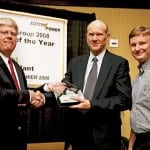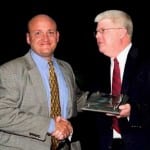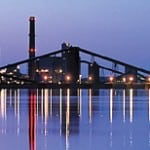Consumption of Powder River Basin coal continues to grow, from 28 million tons annually in the mid-1970s to what is now 400 million tons per year. Existing plants as far east as Nova Scotia burn the low-sulfur coal to comply with increasingly stringent limits on SO2 emissions, and PRB coal has become the fuel of choice for a new generation of coal plants now under construction.
Since 1999, the PRB Coal Users’ Group (PRBCUG) has preached the advantages of using PRB coal and served as a forum for trading information on the safe and efficient combustion of this low-cost and environmentally friendlier, but dusty fuel. Membership in the group continues to grow; more than 350 representatives of 95 generating companies attended this year’s three and one-half day annual meeting (Figure 1).
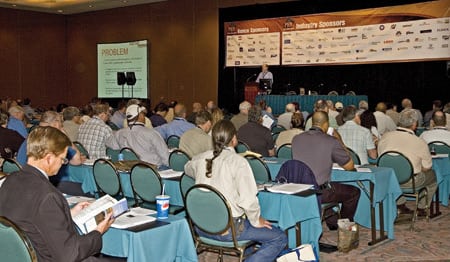
1. Industrywide interest. More than 350 employees of 95 different gencos attended this year’s PRBCUG annual meeting, colocated with the ELECTRIC POWER 2007 Conference & Exhibition. Source: Leslie Claire, POWER magazine
The meeting—once again sponsored by Benetech Inc.—began with a welcome by outgoing PRBCUG Chairman Charles Kitchens, project manager of Southern Company’s engineering and construction services, and was followed by a panel discussion. Kitchens emphasized that the group’s mission is to develop and refine industry best practices by capturing its members’ wealth of knowledge (see box). The incoming PRBCUG chairman—Robert Taylor, safety and protection leader for American Electric Power—assumed his responsibilities at the close of the meeting.
Railroads boosting PRB capacity
Kitchens wasted little time asking the panelists to address one of the major issues facing PRB users—transportation. The panel discussion began with short presentations by Sami Shalah, VP of coal marketing for BNSF Railway; Doug Glass, VP and general manager for energy of Union Pacific Railroad; and Kurt Kost, a senior VP and head of western operations and process management for Foundation Coal. Their common theme was the challenges of moving increasing quantities of PRB coal reliably and cost-effectively.
Shalah, explaining that BNSF primarily serves the U.S. west of the Mississippi River, said that of his carrier’s recent 6.1% average rise in unit volume shipments, coal led all categories of freight with an increase of 9.8%. He also noted that BNSF has doubled PRB coal shipments to customers in eastern states since 2000, from 50 to 100 million tons a year.
The total tonnage handled by the joint rail lines out of the Powder River Basin grew 16% from 1999 to 2006. However, a 54% increase in volume over the next six years will be required to satisfy near-term demand for PRB coal, which is expected to grow to 500 million tons by 2012. Shalah reported that key portions of the joint line that have the greatest traffic have been triple-tracked to handle the expected volume increase. One 18-mile segment will even be quadruple-tracked this year to relieve congestion. Last year, BNSF alone spent $626 million to expand its capacity, and this year it’s devoting another $618 million to similar efforts.
Glass followed Shalah with a short description of the 32,400 track miles that constitute the Union Pacific System (UP). About 20% of the company’s 2006 revenues of $3 billion came from moving PRB coal out of the Powder River Basin, he said. UP’s growth in coal deliveries has paralleled that of BNSF, from 48 million tons in 1990 to 194 million tons in 2006. Further growth of at least 10% is expected this year.
Significantly, per-train volume has grown as well—from 12,000 tons in 1995 to 15,000 tons in 2006—and that has placed even more strain on the track system. Glass ended by emphasizing that UP is committed to making the investments in the system needed to reliably meet growth in demand for PRB coal
Kost took a somewhat different tack by discussing coal supply chain challenges from the perspective of a supplier, rather than a shipper. Although Foundation Coal operates mines in Northern and Central Appalachia as well as in the Powder River Basin, its current production of PRB coal is more than double that of both eastern mines combined. In 2006, Foundation Coal extracted 50 million tons of PRB coal from its mine in Wyoming, which is thought to sit on reserves of 600 million tons. As with BNSF and UP, Foundation’s shipments have been booming, going from 255 million tons annually to 430 million tons over the past 10 years. Kost said his company’s four most serious challenges are acquiring new leases, increasing mine overburden strip ratios (how much soil must be removed to reach the coal seam), increasing labor costs, and the reliability of shipments.
Next on the PRBCUG meeting’s agenda was the presentation of the group’s 2006 Plant of the Year award, which went to Westar Energy Inc.’s Lawrence Energy Center in Kansas. John Bridson, the plant’s executive director of generation, and members of his staff took the stage to accept the honor. The July 2007 issue of POWER will take an in-depth look at the Lawrence Energy Center’s work practices and programs that so impressed the PRBCUG’s board of directors (Figure 2).

2. The PRBCUG’s board of directors. From left to right: Mark Collett, VP of business development for Benetech Inc.; Dave Vendel, fuel handling supervisor of Lower Colorado River Authority’s Fayette County Power Plant; Robert Taylor, safety and protection leader for American Electric Power and incoming PRBCUG chairman; Ed Douberly, president of the Utility FPE Group; Joel Booher, principal engineer for boiler performance of Diamond Power International, Inc.; Charles Kitchens, project manager of engineering and construction services for Southern Company and outgoing PRBCUG chairman; Barry Boswell, director of generation at TXU Corp.’s Martin Lake Power Plant; Jim Wiseman, president of Wiseman Consulting; Don Pearson, manager of regional field engineering services for Babcock & Wilcox; Greg Krieser, plant manager of Omaha Public Power District’s North Omaha Station; and C.J. Saladino, station director of Dominion Energy’s Kincaid Generation plant. Source: Leslie Claire, POWER magazine (Not shown are Randy Rahm, chief operating officer of Ethanex Energy Inc. and executive director of the PRBCUG; David B. O’Neill, director of commercial operations for Alstom Power; and David Johnson, executive director of TradeFair Group and treasurer of the PRBCUG.)
Buyer, beware
A very full first day’s morning session ended with an excellent presentation by Randy Rahm, chief operating officer of Ethanex Energy Inc. and executive director of the PRBCUG. Its title, "Pay me now or pay me double later," emphasized the importance of getting the plant modifications needed to switch to PRB coal implemented correctly the first time.
Rahm advised buyers of the major equipment involved in such modifications to develop fuel specification guidelines and to pass them on to their purchasing group before soliciting bids. Buyers, he said, also should compare prospective suppliers’ experience, qualifications, and promised after-sales service and support, perhaps going so far as to visit their facilities.
Rahm reminded the audience of the inadequacy of using a commodity purchasing process for high-performance, value-added products and services. There is no such thing as "one size fits all" in this business, he said. Rahm urged buyers to insist on a performance-based contract that outlines the key performance metrics—in particular, the measured dust levels—of any system intended to handle PRB coal. Another good idea is to seriously consider including in any supply contract a termination clause for nonperformance.
Purchasing decisions for products and services for mitigating safety risk are particularly easy to "get wrong" if made by purchasing agents, who are unlikely to know first-hand the challenges of handling and burning PRB coal on a daily basis, Rahm explained. He advised against buying any dust-collection or dust-suppression system, transfer chute, or fire-protection or washdown system that has not proven its worth at multiple PRB coal-burning power plants.
You get what you pay for
Rahm then presented three "pay me later" examples to drive his point home. One utility installed the lowest-cost water/mist rotary car dumper dust control system it could find, instead of rebuilding existing dust collectors. After the retrofit, operators had to add air baffles and freeze protection to the entire dumper. Today, they still have concerns about fouled position sensors because they cannot view hopper levels. The original estimated cost of "upgrading" the system was $365,000, but after all the system corrections and fixes were completed, the final cost was over $1 million. That’s significantly more than it would have cost to do the job correctly—not "on the cheap"—in the first place.
Even worse, the ill-fated project strained employee relations. It took two years to resolve the problems with the new dust control system, which operators still refuse to take ownership of and continue to blame for all errors in hopper levels, even those of human origin clearly not caused by the system.
Rahm’s second example described a multiplant utility’s purchase of water treatment and dust suppression chemicals via a single, fleetwide contract. The water treatment chemicals worked as advertised, but the dust suppression chemicals didn’t, probably because the supplier had little experience with them. For the utility, which didn’t realize that, the consequences were dire: three crusher house fires that caused $1.75 million in damage and numerous complaints from operators and neighbors of its plants.
It took three years for the utility to get out of the old contract and sign a new one with an experienced supplier of the right dust suppression chemicals. In the interim, relations between the utility and its operators’ labor union became strained because it appeared that management was dragging its feet about fixing the problem.
Rahm’s final example was of a coal plant that purchased a higher-capacity unloader and new transfer chutes as part of a project to switch to PRB coal. Under the gun to cut costs, the plant’s purchasing department chose the lowest bidder for the job, despite concerns that the vendor would be unable to meet the project schedule. Those concerns were well-founded: The chutes were not installed in time for commissioning of the new unloader. The snafu forced operators to work significant overtime and delayed completion of the entire project. The cost of this mistake was estimated at $750,000.
Finding and fighting fires
During the Day 1 afternoon session of the PRBCUG annual meeting, Jim Velandra of Detroit Edison’s Monroe Power Plant described in great detail how to detect a fire in a coal silo and—more importantly—what to do about it.
Monroe Power Plant is one of the largest in the U.S. Its four units, with a combined capacity of more than 3,000 MW, burn an average of 33,000 tons per day of blended coal—60% western and 40% eastern. The plant has 28 coal silos that are 18 feet across and 65 feet tall. Each can hold 360 tons.
As any coal-plant operator knows, it’s more difficult to fight coal dust fires in silos than fires in open areas. Limited access and close working quarters are the two biggest reasons. Firefighters must scale the silo before inserting hoses either to quench a fire or wash down the silo. In 2004, a firefighter working atop one of the silos at Monroe was overcome by carbon monoxide (CO) and had to be hospitalized.
At the Monroe plant, after a silo has been out of service for seven days, it is typically monitored once per shift by a thermal imaging gun. If the gun detects a hot spot, the monitoring frequency is increased to several times a shift. If the temperature rises above 130F, additional steps are taken. Plant managers have decided that monitoring levels of CO is not a reliable way to detect PRB coal fires for two reasons: Dust collectors can remove the gas before it builds up to alarm level, and PRB coal dust has a tendency to plug the filter of CO sensors.
Comments from the floor during the Q&A following Velandra’s presentation made clear that different plants have different rules for how long it is safe for an out-of-service silo to contain PRB coal before it should be emptied and washed down. The durations ranged from 24 hours to three days.
Having experienced several coal silo fires caused by spontaneous combustion, managers of the Monroe plant decided that what was needed was a system that could either prevent such fires or suppress them without putting anyone in harm’s way. After talking to several vendors, the managers purchased a system that makes use of the existing high-pressure water risers near each bank of silos but also incorporates four independent chemical injection systems—one per unit, each with its own header and chemical, air, and water supply.
Each header provides coverage for seven silos, and each silo is equipped with a manually operated control panel through which an operator or firefighter can inject into the silo a mixture of fire suppressant and water, or just water (for a silo washdown). Stainless steel nozzles rated at 80 gal/min and 60 psi provide full coverage of the silo circumference within 24 inches of the top. The design of the nozzle allows it to be removed from the top of the silo.
The new system was commissioned in March 2006. Four months later, it prevented—within minutes—a hot spot from developing into a fire after the seal air was turned on in a silo that had been out of service. The system also is frequently used to wash out the silos and keep the nozzles clean.
More to come
The second day of the meeting forced PRBCUG members to choose from among three interesting tracks: Coal Handling, Boiler & Combustion, and Safety, Fire & Risk Management. Space constraints preclude highlighting the best of the many excellent presentations made by O&M personnel from PRB coal-fired plants across the U.S. (Figures 3 and 4). But rest assured that material from several of them will find its way into POWER‘s pages in the near future.

3. On the mike. Kevin Hayes, fuel supply supervisor (L) and Andy Payne, first-line supervisor of Detroit Edison’s Monroe Power Plant, take questions from the audience after presenting "Problems associated with handling and storage of western coals." Source: Leslie Claire, POWER magazine
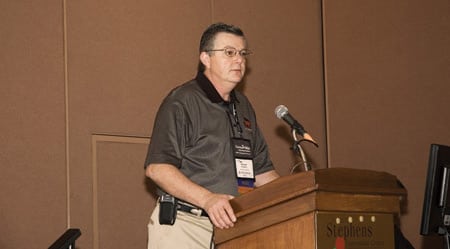
4. Better safe than sorry. Ed Douberly, president of the Utility FPE Group and a member of the PRBCUG’s board of directors, presented "PRB safety: Responding to and addressing PRB-related hazards" to attendees of the meeting’s Safety, Fire & Risk Management track. Source: Leslie Claire, POWER magazine







